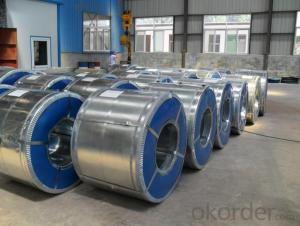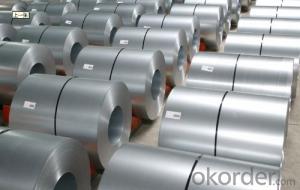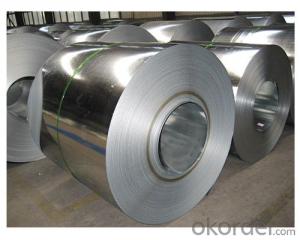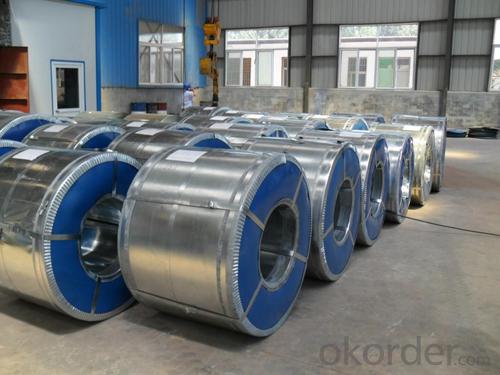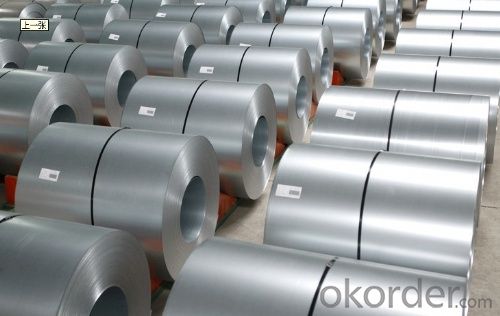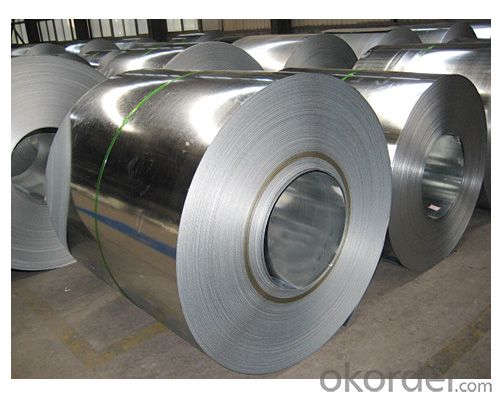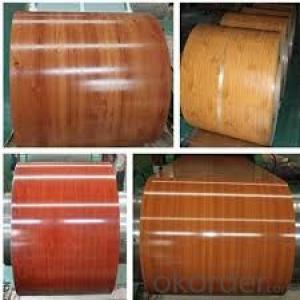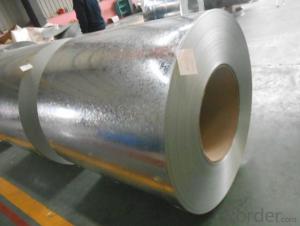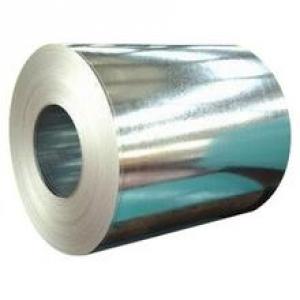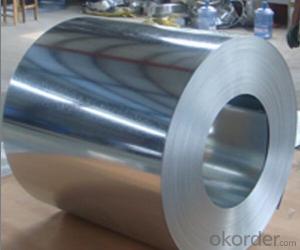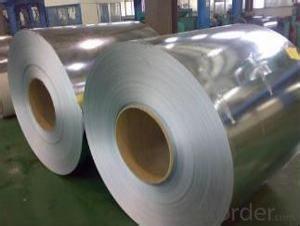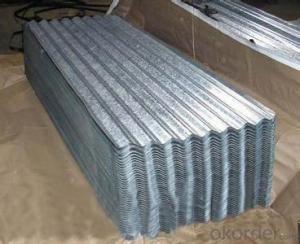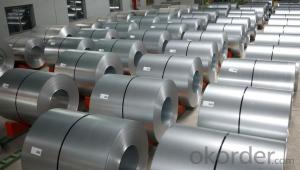Hot dip galvanized steel coil & sheet
- Loading Port:
- China Main Port
- Payment Terms:
- TT OR LC
- Min Order Qty:
- -
- Supply Capability:
- -
OKorder Service Pledge
OKorder Financial Service
You Might Also Like
Commodity | Hot dip galvanized steel coil and sheet |
Technical Standard: | JIS 3302 / ASTM A653 / EN10143 |
Grade | DX51D / DX52D/ DX53D/ S250,280,320GD |
Types: | Commercial / Drawing / Deep Drawing / Structural quality |
Width | 500/650/726/820/914/1000/1200/1219/1220/1250mm |
Thickness | 0.12-2.8mm |
Type of coating: | Galvanized |
Zinc coating | Z30-275g/m2 |
Surface Treatment | Chromed / Skin-pass/ Oiled/Slightly Oiled/ Dry/ Anti-fingerprint |
Surface structure: | Zero spangle / minimized spangle / regular spangle/ big spangle |
ID coil | 508mm or 610mm |
Coil weight | 3-8 MT per coil |
Package: | Properly packed for ocean freight exportation in 20''containers |
Application: | Industrial panels, roofing and siding for painting |
Price terms | FOB,CFR,CIF |
Payment terms | T/T or L/C |
Delivery time | Within 30 days |
Remarks | Insurance is all risks |
MTC will be handed on with shipping documents | |
We accept the third party certification test,such as SGS/BV |
Technicaldata :
Hot dipped galvanized coil Technical Data
Chemical Composition | ||||||
GRADE | C | Si | Mn | P | S | Ti |
SGCC/DX51D+Z | ≤0.10 | ≤0.50 | ≤0.60 | ≤0.10 | ≤0.030 | ≤0.020 |
DX52D+Z | ≤0.10 | ≤0.50 | ≤0.60 | ≤0.10 | ≤0.030 | ≤0.020 |
SGCD/DX53D+Z | ≤0.10 | ≤0.30 | ≤0.50 | ≤0.05 | ≤0.030 | ≤0.020 |
SGCE/DX54D+Z | ≤0.10 | ≤0.30 | ≤0.30 | ≤0.03 | ≤0.020 | ≤0.020 |
DX56D+Z | ≤0.10 | ≤0.30 | ≤0.30 | ≤0.03 | ≤0.020 | ≤0.020 |
Structural | ≤0.20 | ≤0.60 | ≤1.70 | ≤0.10 | ≤0.045 | |
|
|
|
|
|
| |
Hot dipped galvanized steel coil Mechanical Properties | |||
GRADE | Yield Strength MPa | Tensile Strength MPa | Elongation % |
SGCC(DX51D+Z) | ≥205 | ≥270 | - |
SGCD(DX53D+Z) | - | ≥270 | 38 |
SGCE(DX54D+Z) | - | ≥270 | 40 |
DX56D+Z | - | ≥270 | 42 |
- Q: What are the common applications of hot-dip galvanized steel coils?
- Hot-dip galvanized steel coils have a wide range of common applications, including roofing and construction materials, automotive parts, electrical appliances, and agricultural equipment. The galvanization process provides excellent corrosion resistance, making these coils ideal for outdoor structures and applications exposed to harsh environments.
- Q: why does steel have a density range when other metals do not?
- Steel is not a pure element it is an alloy. Steel is primarily iron but it has many elements blended in that change it's density including carbon,silicon, nickel, chrome, etc. Aluminum and copper , magnesium and so forth can be the pure element or they can be alloys too. If they are alloys, then their densities vary also
- Q: Can steel coils be welded?
- Yes, steel coils can be welded. Welding is a common method used to join steel coils together, whether for manufacturing purposes or repair work.
- Q: How are steel coils processed for edge conditioning or slitting?
- Steel coils are processed for edge conditioning or slitting through a series of steps. First, the coil is unwound and flattened to remove any bends or curls. Then, the edges of the coil are trimmed or conditioned to ensure a smooth and straight edge. After that, the coil is slit into narrower strips using specialized machinery. This process allows for the production of various widths of steel strips, which can be used for different applications.
- Q: I know aluminum is lighter but I'm looking at a 01 bianchi grizzly mountain bike which is steel. I used to ride a specialized stumpjumper m4 which was aluminum. It was quite light so I don't know if I'll like a bit heavier bike but overall what is better from those who have had both?
- Im a huge fan of steel frames. #1. they dont feel like they are bouncing off things like aluminum #2. they absorb more vibrations #3. they can be fixed if you wreck them #4. They dont weigh much more (if anymore) then aluminum #5. you are in a very limited clique #6. a steel frame will far out-live an aluminum frame. #7. it doesnt sound like your riding a tin can. #8. break a hose or cable guide, and you simply can take it down to your local muffler shop and have them weld one back on.. an aluminum frame is so fragile it will probably have to be replaced. Aluminum frames do have their pluses. #1. they are very stiff #2. you dont have to worry about rust #3. every company on the planet makes aluminum frames so they are easy to find... #4. looks. because aluminum is so stiff, there are some very radical frame designs. steel frames are just boring to look at. if you like steel frames, you wont want to go to aluminum. if you like aluminum, you could consider steel.
- Q: What are the different methods of stretch leveling steel coils?
- There are several methods of stretch leveling steel coils, each with its own advantages and applications. 1. Roller Leveling: This method involves passing the steel coil through a series of rollers that apply pressure to stretch and flatten the material. It is a widely used method for leveling steel coils and offers good control over the leveling process. Roller leveling is suitable for thin and medium gauge steel coils. 2. Tension Leveling: In this method, the steel coil is subjected to high tension forces applied by a set of bridle rolls. The tension helps to elongate and flatten the material, resulting in a level and stress-free coil. Tension leveling is particularly effective for thicker and harder steel coils. 3. Laser Leveling: Laser technology is employed in this method to measure and correct any imperfections in the steel coil. A laser scanner scans the surface of the coil and detects variations, which are then adjusted by a laser beam. Laser leveling offers high precision and is suitable for leveling sensitive and high-value steel coils. 4. Stretcher Leveling: This method involves stretching the steel coil beyond its yield point, which causes the material to permanently deform and eliminate any residual stresses. Stretcher leveling is commonly used for heavy gauge coils and can achieve significant flatness improvements. 5. Tensionless Leveling: As the name suggests, tensionless leveling is performed without applying tension to the steel coil. Instead, hydraulic or pneumatic pressure is used to stretch and flatten the material. This method is suitable for delicate or sensitive steel coils that may be prone to damage under high tension forces. Each method of stretch leveling steel coils has its own advantages, such as control, precision, or suitability for specific types of steel coils. The choice of method depends on factors like the thickness, hardness, and quality requirements of the steel coil, as well as the desired flatness and surface finish.
- Q: My musical saw has, despite my best efforts, got little patches of rust on it. How Do I go about removing the rust without spending too much on rust-removal products and without affecting the properties of the steel?
- Steel wool and a bit of WD 40. Steel wool will remove the rust and the WD 40 will protect it in the future.
- Q: How many millimeters is a number 3 steel crochet hook?
- Steel Crochet Hook
- Q: How are steel coils inspected for chemical composition?
- The chemical composition of steel coils is examined using spectroscopy, a process that involves the utilization of a spectrometer. This instrument analyzes the light emitted or absorbed by a sample to determine its chemical makeup. Normally, a small portion of the coil is taken and prepared for analysis in the case of steel coils. This portion is then placed in the spectrometer, where a beam of light is emitted onto it. The light interacts with the atoms and molecules in the sample, causing specific wavelengths of light to be emitted or absorbed. The spectrometer measures the intensity of the emitted or absorbed light at different wavelengths and generates a spectrum, which is essentially a distinct fingerprint for the sample. This spectrum is then compared to a database of known spectra for various elements and compounds to ascertain the chemical composition of the steel. Through spectroscopic analysis, the presence and concentration of different elements like carbon, manganese, phosphorus, sulfur, and other trace elements in the steel can be identified. These elements have a significant impact on the steel's properties, strength, and suitability for different applications. Ensuring that the steel complies with the required specifications and standards, inspection for chemical composition is crucial in the steel industry. Any deviation from the desired chemical composition can potentially compromise the steel's performance and result in structural failures or other defects. In conclusion, spectroscopy offers a highly precise and dependable method for examining the chemical composition of steel coils. This aids in maintaining the quality and integrity of the steel products.
- Q: I'm searching for the elastic modulus of ASTM A653 galvanized steel sheet. Max points for first person with a response that includes web address of reliable reference - I just haven't found it yet. thanks!
- Aluminum is non ferrous so a magnet won't persist with it, and this is softer than steel. once you have desperate that, if it has previous paint on it, this is particularly helpful to apply a primer that corresponds to the paint you would be utilising the two vinyl or oil based, then paint. this is possibly no longer Galvanized, yet whilst this is, the unpainted floor with have a 2 colour steel Spackle look.
Send your message to us
Hot dip galvanized steel coil & sheet
- Loading Port:
- China Main Port
- Payment Terms:
- TT OR LC
- Min Order Qty:
- -
- Supply Capability:
- -
OKorder Service Pledge
OKorder Financial Service
Similar products
Hot products
Hot Searches
Related keywords
